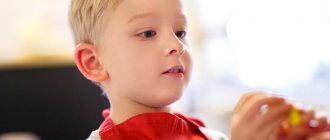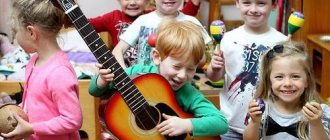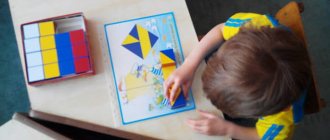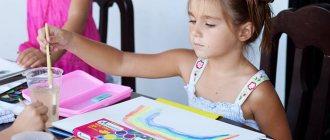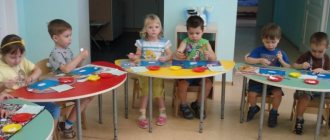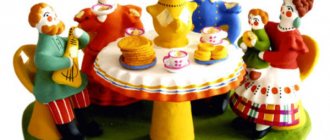Musical development of preschoolers
Musical development is very important for any child. And this does not mean at all that it is necessary to raise a brilliant musician from a baby from the cradle, but it is within our power to teach him to listen, understand music, and enjoy it. When should musical development begin and what should it consist of?
Musical development contributes to the holistic formation of a child’s personality. While listening to music, the central nervous system and muscular system develop, the process of socialization is facilitated, artistic thinking and a sense of beauty develop.
From birth to 2 years
As you know, auditory perception (unlike visual perception) is very well formed by the time the baby is born. While still in the mother's tummy, the baby hears her voice. The child repeats human speech and animal sounds. Inanimate nature (the knock of a door, for example) does not interest him at all. Researchers have noted that the babble of all children in the world is the same, regardless of what language is spoken around them. Turning to rattles, it is worth noting that they produce a wide variety of sounds - dull, crackling, like maracas, or ringing, like a bell. When purchasing them, try to select as wide a range of sounds as possible. Invite your baby to compare the sounds of different rattles. Currently, electronic musical toys (mobiles, musical mats, electronic pianos, etc.) occupy a large niche in the children's goods market. It is important that the music played is recognizable and of good quality. It is also valuable that in order to extract a sound (melody), the baby will need to perform an action - hit a key, turn a lever, touch a toy, etc. This will contribute to the formation of cause-and-effect relationships at the “response-stimulus” level, thereby developing the cerebral cortex.
For a very young child, you intuitively offer calm lullabies before bedtime, and playful and rhythmic songs while awake. A two-year-old child can be asked to choose for himself which option from the proposed musical excerpts is most suitable, for example, for charging. Explain what the expression “doing to music” means. Children will understand its meaning perfectly if they do not hesitate to exaggerately seriously depict marching movements to Grieg’s music. It turns out? No. Movements to this music should be smooth and measured. Of course, you can use recordings of songs from cartoons. But don’t be lazy to add variety. Children respond very well to “soft” jazz compositions (with an easily discernible main theme). It is good to offer them before going to bed. For example, works such as “Summertime” by J. Gershwin, “Hosanna,” and almost any work by Weber are suitable. From the repertoire of classical music, you can stop at Beethoven’s “Fur Elise” and the 14th Sonata (Lunar), Griboedov’s waltzes, Glinka’s nocturnes, Grieg’s “Peer Gynt”, Massenet’s “Elegy”.
For an active pastime, take the Italian polka and Rachmaninoff’s 14th concerto, Mozart’s Turkish rondo, Khachaturian’s waltz to the drama “Masquerade,” and a joke from Bach’s orchestral suite. Nowadays there are a great variety of thematic CDs with recordings of musical works arranged for children. These are variants of popular works without chords and second themes that are difficult for a child’s ear. Almost the same melody sounds. At any age, it is pleasant and useful for a person to listen to recordings of the sounds of nature - a babbling stream, a raging sea, rustling rain... But do not forget the immutable rule - talk to your child about what he heard. Ask your child if he liked it, what he thought about while listening, what feelings he experienced. After all, it may turn out that he has unpleasant associations. Discuss everything you heard for the first time, paying attention to the emotional side (what feelings, images arise).
2–3 years - first instruments
We have already become proficient in listening to music, and the good old, but already boring rattles are being replaced by real musical instruments. In this age range, it would be most optimal to pay attention to familiarization
baby
with musical instruments .
Drum
, you can be sure it will be received with a bang. Invite the young drummer to slap the drum with his palm, then tap with his finger; the surface can be stroked. Beat the drums; Although the baby is not yet able to do such exercises, by doing this you will expand the range of sounds produced for him and stimulate interest in further manipulations. The chopsticks should be put aside for now to avoid injury.
Then we offer a tambourine
- in fact, a complicated version of the drum - you can beat and ring.
Show your baby how to accompany any melodies. There are many accompaniment options. The simplest one is hitting the downbeat—places that sound stronger and clearer. For example, “There was a grasshopper sitting in
the
grass
,
just like a
little
cucumber
,
”
and
the trembling of bells for drawn-out vowels. “The Waterman’s Song” is perfect, in particular the phrase “I’m dying to fly” or “Winged swing”, that is, slow melodies. These musical instruments are the best way to show what tempo and rhythm are. Kids perceive the association with steps well. Top... Top... Top... (pause for 2-3 seconds). Top. Top. Top (at normal pace, without pauses). Top-top-top they ran (quickly). Now also with your fingers on the drum/tambourine. Check if your baby understands you by listening to children's songs. They tend to exhibit a distinctly fast or slow tempo. In the first case, “Or maybe a crow”, “Little Red Riding Hood’s Song”, “Dance of the Little Ducklings” are suitable. The slow pace is perfectly illustrated by “Song of the Waterman”, “Song of the Turtle and the Lion Cub”, “Lullaby of the Bear”. It is important that listening to children's songs initiates the baby's singing activity, promotes speech development, and enriches the passive vocabulary. Attempts to sing along will contribute to the development of the articulatory apparatus, and correlating the musical theme with your favorite cartoon will create a positive mood and improve your emotional state. Children usually do not hesitate to sing out loud, unless “kind” adults once said something unflattering about such singing. Do not allow this to happen, otherwise you will have to correct the mistakes you have made - fearlessly demonstrate your love of singing by personal example. The next step is to show different sound durations and rhythms. So, with your left hand, beat the drum slowly and rhythmically (every two seconds), then add your right hand (every second). We get one blow with the left - two blows with the right. Now invite your baby to “replace” your left hand - first let him put his palm on top and feel the rhythm, then quietly remove your palm. And before us is a tandem of drummers! Then you change “scores”, speed up or slow down the tempo, change the beat ratio (1:4), etc.
And now - spoons
. You don't even need to buy them. There are probably a couple of wooden spoons around the house. Fold them with the back sides, fasten the ends for convenience with an elastic band. It is quite enough for initial acquaintance. You need to hold the spoons by their fastened tips, without squeezing them too tightly, otherwise, when squeezed, they will not make a knock. It is not so easy for children to grasp spoons correctly; it is much more common to grasp them more tightly, like a rattle. You will need to achieve some relaxation. The sound of spoons is traditionally combined with folk songs and chants, but almost any rhythmic melody will do (“Dance of the Little Ducklings”, “Antoshka”, “If only there were no winter”).
If you suddenly find a ratchet
, you can also offer it to your child. Just like spoons, this instrument requires some coordination of movements to produce sound. This requires coordinated work of the muscles of the hand and forearm. Playing the rattle is convenient to accompany chants and ditties (you can use “Ditties of grandmothers hedgehogs”).
After 3 years
You can offer your baby
a metallophone .
Melodic scales can inspire children's creativity - their little ears have never heard anything like this. It should be taken into account that the stick should be held lightly, without squeezing, otherwise the sound will not be clear. The kids don’t “catch” this moment right away, but over time everything will start to work out.
4 years - listening to music
The four-year-old listener is already quite experienced, still inquisitive, restless and impatient. Right now you should spend most of your time listening to music.
. While listening to a piece of music, your child will easily understand the tempo and identify the instruments he knows. It's time to expand his horizons and introduce him to new musical instruments. This will allow you to use an important mental function when listening to music - analysis, which is necessary for the mental development of the baby. With new knowledge, the child is ready to attend the conservatory. You can anticipate your cultural journey by watching videos of concerts, analyze and discuss what you hear. Music, it turns out, can tell a lot about itself. Not only about tempo, rhythm and composition of instruments. Let's get acquainted with the words “major” and “minor”. The antonyms fun - sad will help make them accessible to the child’s understanding. And offer to determine which work is suitable for what. For minor, you can take “The Doll’s Disease” by Tchaikovsky, and for major, “Turkish Rondo” by Mozart. Major is always confident, joyful, flaunting, minor is sad. It is even easier for children to determine the nature of music as follows: major - you want to laugh, minor - you want to cry. The baby needs to choose what is best to do while listening to the music and “make a diagnosis.” To consolidate this material, it is good to practice on the following pieces of music. Minor - “The First Loss” by Schumann, “Dance of the Little Swans” by Tchaikovsky, Russian folk song “A Birch Tree Stood in the Field.” Major - “Italian Polka” by Rachmaninov, “Clowns” by Kabalevsky, “Chunga-Changa”. Now the words sound even more strange, but they are even easier to explain: staccato - sharp, jerky and legato - smooth, slow. When performing staccato, each sound “speaks” separately, waits for its turn, and in the case of legato, the sounds “flow” into one another. For example, “There was a birch tree in the field” is an obvious legato, the song “Smile” is an undeniable staccato.
And, of course, it is worth organizing acquaintance with a wider range of musical instruments. The kid is already familiar with the drums. From the keyboard
It is quite possible to show a piano, mention the organ, harpsichord (the child will see them at the conservatory).
wind
group It would be good if, along with the sound, you could show an image of the instrument. Before going to the conservatory, tell your child about the rules of behavior in this place. Explain that it is not customary to talk, get up, or make noise during a performance. For beginners, subscriptions to short-term concerts are offered. You can visit the concert hall of the Russian Academy of Music. Gnesins. It hosts Sunday afternoon concerts; Among other works, sketches by Liszt (for example, “Round Dance of the Dwarves”), Grieg’s music for Ibsen’s play “Peer Gynt”, and Saint-Sane’s “Carnival of the Animals” are performed. It will be very nice if, during the first visit to the conservatory, the child hears already familiar works - this will make it possible to more clearly appreciate the difference between playback from a disk and “live” sound. For your first visits, you can choose a cycle of plays by Kabalevsky, works of small forms by Mozart, and folk songs. Next, choose the musical fairy tale “The Wolf and the Seven Little Goats”, the operas “The Tale of the Dead Princess and the Seven Knights”, “Rikki-Tikki-Tavi”, “Flint”. No less interesting for your child will be a visit to the Russian Center for Museum Pedagogy of Children's Creativity at the State Russian Museum. You can go there with a two-year-old child, for example, for the “At the Art Museum with Mom”, “Games with Sounds and Colors” subscription. For 4-year-old children, we offer the “Meetings with the Beautiful” subscription. At the Moscow International House of Music, children and their mothers will be offered a fabulous concert “The Little Humpbacked Horse” and “The Tale of Tsar Saltan” based on the opera of the same name by Rimsky-Korsakov. At the Moscow New Opera Theater named after. E. V. Kolobova will present the opera “Cat’s House” to the attention of young listeners. You can also visit the children's musical theater named after. N. Sats with a rich repertoire of performances for children. Interesting performances can be seen at the “Experiment Kommersant” musical theater. The most successful productions are “A Kitten Named Woof”, “The Flying Ship”, “The Cat Who Walked By Itself”.
At the age of 4 years, it is useful to become acquainted with such a technique as meditation to music. Quite recently, the crisis of three years has passed (or you are still in the process), the baby is aware of himself in the world around him separately from you, feels like an independent person, but this is not so simple. Try meditating with your child. An important condition is a balanced, calm emotional state of the parents. Choose calm, transparent music, without disturbing sounds. Recommended works: compositions by Kitaro, “Spectral Suite” by Steve Halpern, “Evening Serenade” by Schubert, “Song of Solveig” by Grieg. You will also need soft pastel or oil pencils and a sheet of paper. Meditation time is 20–30 minutes. Place your baby in a cozy, warm place, dim the lights, turn on your chosen music and start telling a story. Something like this: “It was a long time ago (or just recently). In a distant country lived the Sun and Light. They loved each other very much. And when they had Ray, they were happy. The little ray grew very quickly, warmed everyone with its warmth and gave joy to those around it. He was taught by the best sages, and he began to understand the language of animals and birds, the language of wind and waves. .. When Luchik grew up, he decided to go traveling to help everyone else. And while wandering, I saw a wonderful house with music playing in it. He went there and saw what he needed so much...” Now invite the child to draw what Ray saw. What he really needs himself. If the child doesn't want to draw, let him tell. In this exercise, music helps the child relax, identify with the hero of the fairy tale, and therefore feel loved and happy. This image of family has a positive impact, the journey illustrates reasonable independence.
5–6 years old - everything is “grown-up”
At the age of 5–6 years, the creative spirit in children is literally in full swing, but at the same time they are already much more disciplined than a year or two ago. Creating and making noise is an urgent need for a preschooler. So it's time to move
from listening to
playing .
We invite you to organize a musical noise orchestra.
This is a fairly noisy event, which will require background music, which will create the necessary mood and set the rhythm. African or Japanese drums and maracas are suitable. The process of making instruments is no less fascinating. Cans of water, glass and plastic bottles with peas, beans, buckwheat, tambourines, spoons, a comb, buckets, rubber balls, even an abacus will come in handy. Anything that can be used to produce at least some sound will do. Having staged a piece of music, we listen to it, delve into it, and create the mood. After that, we try to complement the sound on our own. It’s better to try all the instruments, then give out preferences. Perhaps at first the baby will not get any melody. If he's just hitting with tools, don't interrupt the action. This is a great way to get rid of negative emotions and unwind. Next time the process of synthesis and creation will begin. The lesson will be more effective if two or three children take part in it. The work becomes more complicated, but the number of tasks to be solved also increases. We'll have to learn to listen to each other. For you, this is an opportunity to assess the emotional state of your child and give him the opportunity to improvise. At this age, we continue to expand the repertoire of musical works that can be offered to the child for listening. You need to select musical pieces according to the baby’s mood; you can positively influence his emotional state. For 5–6 year old children,
- when overworked - “Morning” by Grieg, “Polonaise” by Oginsky;
- in a bad mood - “To Joy” by Beethoven, “Ave Maria” by Schubert.
- for severe irritability - “Pilgrim Choir” by Wagner, “Sentimental Waltz” by Tchaikovsky.
- with decreased attention - “The Seasons” by Tchaikovsky, “Moonlight” by Debussy, “Reverie” by Schumann.
Based on this list, you can supplement it, taking into account the tastes and needs of your baby.
Source: magazine “Baby and Mom” No. 11, 2007
Maria Montessori system
Just a few words about the wonderful Italian teacher Maria Montessori (1870-1952). Maria was the first female doctor in Catholic Italy. She was not a musician, but for many years she ran a kindergarten, worked with children with disabilities, had a keen sense of child psychology and understood that music was an important component of education. Its main pedagogical principles are the interest of children and their free choice. In her kindergarten, Maria turned to the system of musical education that was closest to her. Towards the Carl Orff system. At the same time, she introduced some original features into the Orff system. This always happens when two viable systems come into contact: one feeds the other. Montessori considered the most important task of parents to be to organize a developing space for the child . So that everything he needs is at hand. Next, the baby will make his choice. In our case, the musical instruments recommended by Carl Orff were laid in front of the child, and he himself chose the one he liked best. At the right time for him.
In addition, Mary was a believer and believed that children most accurately and adequately express the plan of God, the plan of the Creator, and they are able to find their own path. Parents are more observers than educators.
Improvisational technique of Carl Orff “Schulwerk”
The approach is designed for children with different levels of ability and involves the development of creative imagination through the use of tools. When improvising, kids do not learn compositions from notes, but create their own. The technique suggests playing out a certain plot or story with the help of music. By singing the text, selecting movements and accompanying this by playing simple noise instruments (triangle, bell, xylophone), the child gains knowledge of how to create a pleasant sound, convey emotions not only with words, but also with sounds. By emotionally experiencing the underlying plot, finding means of expression, Carl Orff’s technique develops imagination and forms a love for such activities.
This technique combines all three main musical directions and allows you to tell your baby about music in a simple, accessible playful way. The main motives used for teaching are ethnic and folk songs from different countries. Children trained using the Carl Orff method subsequently become interested in their own culture and strive to study it.
Helen Hayner Method
Helen Hayner (Elena Nikolaeva) graduated from the Moscow Conservatory in piano, later moved to the USA, where she has been working at a music school and giving private lessons for about 30 years. With the literary help of Nikolai Kuznetsov, she wrote the book “Becoming a Musician? Easy!”, in which he shares his experience of musical education. An experience that certainly has some original moments. Including those that may be of interest to moms and dads. Let's stop at them...
Raising a good music listener is more important than raising a musician. Much depends on what goals the teacher sets for himself. Hayner believes that it is not necessary to specifically set professional tasks for the student. You shouldn’t go out of your way (as is customary in Russian music schools) to try to raise your child to a professional level.
The best way for a child to develop musically is to learn the piano. Not listening to music, not singing, but learning to play the piano. Moreover, a piano (not a violin, not a recorder, not K. Orff’s noise instruments), in Helen’s opinion, is best suited for this purpose. In other words, the best music lessons are piano lessons. Everything else (playing in an orchestra, singing in a choir) is unproductive and therefore unnecessary. Hence the conclusion: all children should be taught the piano. Moreover, Helen prefers electronic piano for learning. It can be played in different voices, which is interesting for the student. You can record and listen to your child’s play on it. Which is also important.
Teach strictly following the rule: from simple to complex. This didactic principle, according to Heiner, should form the basis of learning to play an instrument. The main thing for the teacher is to find that gradual path (without jumping over steps) along which the child can slowly but surely rise to the top. This, according to the American teacher, is his art. Anything that is overly complicated will inevitably cause a young student to have a negative attitude towards classes.
Early training of Shinichi Suzuki
Methods of early learning to play musical instruments. The author began teaching children 2-3 years old to play the violin and by the age of 4-5 he had created wonderful ensembles of little performers.
The main message is based on three ideas:
- All children are musical from birth; the main thing is to recognize talent in a timely manner and develop it.
- Only those who love children with all their soul achieve success. Being strict and demanding, you need to have a great feeling for the child, without this nothing will work.
- The best teacher is a parent. Having the proper attitude towards the baby, only a mother or father can convey to him the necessary information and teach him the necessary skills.
Training in the Suzuki technique involves daily classes, but they are aimed not so much at teaching music, but at developing a worthy and well-mannered person.
Zoltán Kodály system
The remarkable Hungarian composer, like D. Kabalevsky, attached great importance to the musical education of children.
Here are some of the main provisions of his system. There are no non-musical children. Non-musical adults are those whose musicality was not noticed or developed in childhood. Therefore, Kodaly, who enjoyed great authority in Hungary, managed to achieve something that had never happened in any country in the world - music lessons in a regular, comprehensive school became daily and took more hours than all other subjects.
The main thing in musical education is singing and recording melody by ear. This is what was mainly taught in the Hungarian school. The best and most accessible instrument is the voice, Kodály believed. Therefore, singing is more important than playing an instrument.
A person's education cannot be complete without musical education. Cultivating good musical taste, according to Kodai, is not only a family matter, but the most important social and state task.
As a method of early musical education, Zoltan Kodaly suggested that educators, especially fathers and mothers, teach children to walk and clap to the rhythm of a song.
Zoltan Kodai identified four elements that distinguish a musical person from a non-musical person: developed hearing, developed intellect, developed feelings and developed hands.


